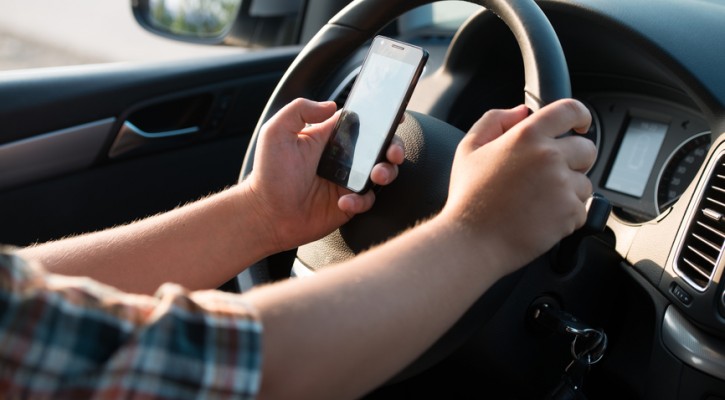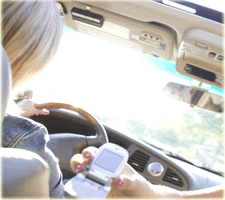Category Archive: Texting

Rear Ending A Police Car While Texting; Not A Good Move
March 9, 2014
A Witchita driver had a partially completed text on his cell phone when he rear-ended a police car at 60 mph. The cruiser had its emergency lights flashing and thankfully, the police officer wasn’t in the cruiser at the time. Read more: http://www.kansas.com/2011/04/20/1816385/traffic-snarled-by-wreck-involving.html

Teens Texting More Than Ever
March 19, 2012
A recently released study by the Pew Research Center’s Internet and American Life Project shows that teens are texting more than ever and, it seems, they prefer texting to phone conversations. The findings don’t bode well for motor vehicle safety groups who are trying to spread the word about the dangers of texting and driving. The greater portion of the increase in texting by teens falls in the age group of those just beginning to drive.
The study’ authors conducted phone interviews in both in English and in Spanish with a “nationally representative sample of 799 teens ages 12 to 17 years old and their parents living in the continental United States” in 2011. They found that texting is the “dominant daily mode of communication between teens and all those with whom they communicate.” Here is some of the information revealed in the study:
- “Overall, 77% of those ages 12-17 have a cell phone. The percentage of younger teens ages 12 and 13 with cell phones has declined slightly since 2009
- The frequency of teens’ phone chatter with friends – on cell phones and landlines – has fallen
- The typical American teen is sending and receiving a greater number of texts than in 2009. Overall, 75% of all teens text.
- The median number of texts (i.e. the midpoint user in our sample) sent on a typical day by teens 12-17 rose from 50 in 2009 to 60 in 2011.
- Much of this increase occurred among older teens ages 14-17, who went from a median of 60 texts a day to a median of 100 two years later. Boys of all ages also increased their texting volume from a median of 30 texts daily in 2009 to 50 texts in 2011. Black teens showed an increase of a median of 60 texts per day to 80.
- Older girls remain the most enthusiastic texters, with a median of 100 texts a day in 2011, compared with 50 for boys the same age.
- 63% of all teens say they exchange text messages every day with people in their lives. This far surpasses the frequency with which they pick other forms of daily communication, including phone calling by cell phone (39% do that with others every day), face-to-face socializing outside of school (35%), social network site messaging (29%), instant messaging (22%), talking on landlines (19%) and emailing (6%).
- The heaviest texters (those who exchange more than 100 texts a day) are much more likely than lighter texters to say that they talk on their cell phone daily. Some 69% of heavy texters talk daily on their cell phones, compared with 46% of medium texters (those exchanging 21-100 texts a day) and 43% of light texters (those exchanging 0-20 texts a day).
- Some 23% of all those ages 12-17 say they have a smartphone and ownership is highest among older teens: 31% of those ages 14-17 have a smartphone, compared with just 8% of youth ages 12-13. There are no differences in ownership of smartphones versus regular cell phones by race.”

Texting and Driving: What happens when a vehicle comes in your lane.
January 20, 2012
You can read about it several times a week; a driver who is either texting, using a cell phone, or engaged in some other form of distracted driving, drifts over into the oncoming lane causing a crash. This type of crash is becoming all too common and unfortunately, death is often the result. Head-on crashes are the worst type of crash with the greatest potential for serious injuries and death. However, a driver in your lane doesn’t automatically have to result in a head-on crash if you are prepared.
To be prepared for the unexpected drivers should always use the S.I.P.D.E method of defensive driving. That is:
- Search the driving scene – Always be aware of what is happening in front of you, to the sides, and behind.
- Identify hazards – Be on the lookout for anything that could be a potential hazard whether that be a driver about to pull out of a parking lot or a driver ahead who is obviously distracted and isn’t looking at the roadway.
- Predict what may happen – When trying to predict what the other driver might do, in order to best prepare yourself, always predict the worst thing that could possibly happen.
- Decide what you will do – Having a decision already in mind if that other driver should do the worst will allow you additional precious time to escape a collision situation.
- Execute your decision – If the worst thing happens, you will have to put your plan into action in order to escape a collision.
Note: Sometimes you may not be able to completely escape a collision, when planning and executing your decision, you may have to choose to lessen the crash forces rather than escape a crash altogether.
If a driver ahead should suddenly swerve into your lane, you may have very few choices but, to avoid or reduce the severity of the crash, follow these tips:
- Honk your horn to alert the other driver.
- Don’t try to swerve to the left into his lane to avoid a crash, he may realize what he is doing and try to swerve back into his lane at the same time.
- Rather than face a head-on crash, it is better to go off the road to the right. There may be hazards there too so steer to avoid them and try to quickly slow to a stop. It is better to go into some bushes than to crash into something hard.
- Sometimes you may face the very tough choice of hitting a car on the right to avoid a head-on crash. Hitting a vehicle that is going in the same direction as you, while still very serious, is often safer than facing a head-on crash.

What is being done to Stop Distracted Driving?
October 12, 2010
Each day there is more research conducted, articles written and information available about the dangers of distracted driving. This increase in awareness is highlighting the growing problem all drivers face on the roadways. Distracted driving has been estimated to cause over 11,500 deaths in the last two years. But what has been done to eliminate the problem? What initiatives are organizations and individuals doing to combat distracted driving?
Forming Organizations
When you Google “distracted driving groups” you will find varied results of individuals banding together to increase awareness on distracted driving, on a local or country-wide basis. The organizations can be as simple as asking people to pledge against distracted driving, like Oprah’s No Phone Zone, or wearing thumb socks to show a driver’s support for not texting while driving. These groups establish their presence online, in various social networking services, making it easier to distribute the message.
Enacting Laws
With the nationwide awareness on the shocking statistics of texting while driving, the Federal, state and local governments and municipalities have proposed and enacted laws to prohibit cell phone usage while on the road. So far, more than 30 states have a law that places a ban on texting while behind the wheel, urging drivers to think twice before they pull out their phones. The type of penalties and amount of fines range from location to location. Currently, the options are being weighed on how to effectively further enforce texting ban laws.
Phone/Text-blocker apps
How to stop phone use while on the road? Simple. Install a phone/text-blocker application. These applications interface the cell phone to the vehicle’s Global Positioning System (GPS) to see if the car is in motion. If so, the application disables the cell phone’s call and/or texting features. With crash-risk increasing four times/talking on the phone and 23 times/texting, it can help discipline the driver into not relying on their phones so much while on the road, until they break the habit.
Mock Crashes
Several local/teen driving advocacy groups have set up mock crashes to remind teen drivers (the group most likely to engage in texting while driving) what could potentially happen if they text and drive at the same time. In most places, the mock crashes are set up at the entrance of the school depicting the wrecked cars, actors as teen drivers, playing dead with phone in-hand. It is a shocking, yet accurate statement that reminds teen drivers of the potential consequences.
Trial Runs
There are also trial course runs, usually hosted by a state’s Division of Motor Vehicles along with several advocates against distracted driving. They allow drivers to experience firsthand what could happen should they attempt to text while driving. Set in an enclosed space, with only traffic cones as obstacles and are operated at low speeds. These courses are designed to show drivers that they are unable to handle both tasks, by challenging them to maneuver their vehicle safety and skillfully while driving distracted.
Advertising and Videos
Various organizations release ads that are either funny or serious in order to make their point. Some organizations do their advertisements a step above by involving the people themselves. They create contests asking drivers if they have what it takes to get the message across, in a video format. The advantages of these types of contests include maintaining a limited budget, creating enthusiasm, spurring creativity and raising safety awareness in teen drivers.
People are motivated to change their behavior in different ways. One or all of these approaches can be incorporated to stop distracted driving. Take a proactive approach to know the dangers and help stop distracted driving.

Distracted Driving Campaigns
July 9, 2010
Buzz, buzz…it will just take a second to check. Ring, ring…it could be important. Yeah, I should go ahead and make that call. It will save me the time and hassle later on. The temptation to reach out and/or respond to some one through a cell phone is great. You have heard the news stories and safe driving campaigns and you know that you shouldn’t, but…do you resist the urge to use the cell phone or let temptation get the best of you?
In order to completely eliminate the urge to use your phone you could turn it off before turning your key in the ignition, lock it up (in the glove box, console, or trunk), or install some of the new technology for cell phones. There are several companies offering services that will restrict the phone’s ability to send and receive text and email messages. Some companies offer services that will restrict calls too. A sampling include:
Textecution – http://www.textecution.com
Textecution is an application designed for parents to install on their children’s phones. It utilizes the GPS features of several handsets to determine if the owner of the phone is moving at more than 10mph. It disables the texting function of the phone. If the person with Textecution on their phone is riding a vehicle as a passenger, or in a bus or train need to use the text feature, there is an “override” option — requesting for text access from the administrator. The parent who installed the phone is designated as the administrator, and can allow, temporarily for the phone to allow texting features. www.safefloridadriver.com
iZUP – http://www.getizup.com/
iZUP disables your phone entirely, removing any distraction from the road. It automatically forwards calls to voicemail and holds text messages while the phone is in motion. It is also time-delayed, to prevent reactivation of the phone’s features in natural stopping areas, like stop lights. The phone will only allow the user to make calls to 911 and 3 pre-approved numbers.
TXTBlocker – http://www.txtblocker.com/
TXTBlocker utilizes GPS locations to detect if the phone is traveling at a car’s moving rate and disables features of the phone accordingly. The installer of the TXTBlocker phone can also designate which areas are no-phone zones, and deactivates texting, calling, email and browsing. There’s also a feature that auto sends a text message to the parent, should the phone be moving at speeds greater than 65mph. Another safety feature for parents is they could check where the owner of the phone is in, based on GPS location. The phone will still be able to dial 911, in case of emergency. It only checks in with GPS every few minutes, so it doesn’t constantly use the phone’s battery.
DriveSafe.ly – http://www.drivesafe.ly/
DriveSafe.ly is a hands-free application that reads out text messages and emails as the phone receives it. There is an optional auto-responder that sends out a customized text message while the application is active.
Committing to be distraction free when you are driving is not easy. But the statistics remind us each day that we are more likely to have a collision when we are distracted, many drivers are making an effort. Regardless of whether it is hand held or hands free, the cell phone is a distraction for every driver.
Learn more about the Measures Taken to Stop Distracted Driving.
